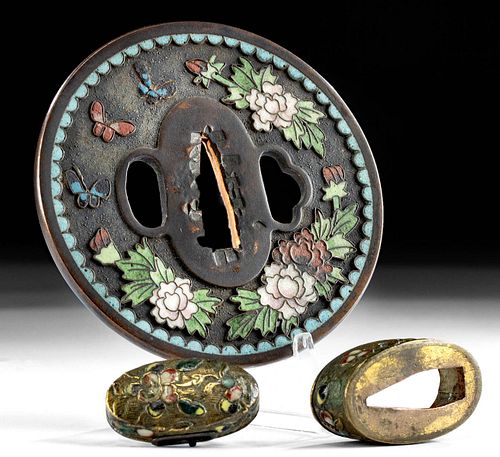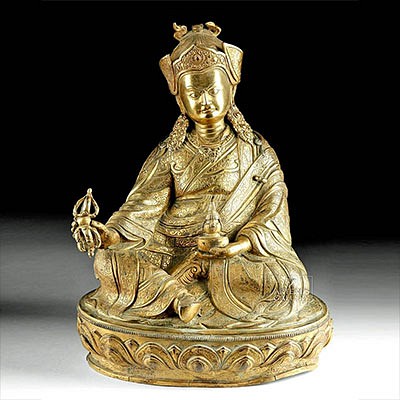19th C. Japanese Edo Tsuba + Habaki + Kashira
Lot 53
About Seller
Artemis Fine Arts
686 S Taylor Ave, Ste 106
Louisville, CO 80027
United States
Selling antiquities, ancient and ethnographic art online since 1993, Artemis Gallery specializes in Classical Antiquities (Egyptian, Greek, Roman, Near Eastern), Asian, Pre-Columbian, African / Tribal / Oceanographic art. Our extensive inventory includes pottery, stone, metal, wood, glass and textil...Read more
Categories
Estimate:
$900 - $1,200
Absentee vs Live bid
Two ways to bid:
- Leave a max absentee bid and the platform will bid on your behalf up to your maximum bid during the live auction.
- Bid live during the auction and your bids will be submitted real-time to the auctioneer.
Bid Increments
| Price | Bid Increment |
|---|---|
| $0 | $25 |
| $300 | $50 |
| $1,000 | $100 |
| $2,000 | $250 |
| $5,000 | $500 |
| $10,000 | $1,000 |
| $20,000 | $2,500 |
| $50,000 | $5,000 |
| $100,000 | $10,000 |
| $200,000 | $20,000 |
About Auction
By Artemis Fine Arts
Mar 11, 2021
Set Reminder
2021-03-11 12:00:00
2021-03-11 12:00:00
America/New_York
Bidsquare
Bidsquare : Art of Asia | Antiquity to Present
https://www.bidsquare.com/auctions/artemis-gallery/art-of-asia-antiquity-to-present-6497
Featuring antiquities, ancient and works of art ranging from the third millennium BCE to the present from China, Japan, South and Southeast Asia, and Korea. Including jades, bronzes, lacquer, textiles, paintings, prints, sculpture, ceramics, metalwork, and other art forms in other media. Artemis Fine Arts info@artemisfinearts.com
Featuring antiquities, ancient and works of art ranging from the third millennium BCE to the present from China, Japan, South and Southeast Asia, and Korea. Including jades, bronzes, lacquer, textiles, paintings, prints, sculpture, ceramics, metalwork, and other art forms in other media. Artemis Fine Arts info@artemisfinearts.com
- Lot Description
East Asia, Japan, Edo period, ca. late 19th to early 20th century. A stunning copper, brass and cloissonned tsuba, a protective and decorative hand guard traditionally employed on Japanese swords. The tsuba is disc shaped, with a Nakago-ana (central blade opening) surrounded by enamel floral motifs of pink peonies and butterflies on both sides. Included is the habaki, which would encircle the blade, and this piece is also embellished with cloisonne flowers. The kashira, or end cap, is similarly adorned with floral motifs. These two smaller pieces are gilded with 4% gold. Size tsuba: 3" Diameter (7.6 cm)
A tsuba is the hand guard of a traditional Japanese sword, usually a katana or tachi. Its primary purposes are to balance the sword, prevent one's hand from sliding down the blade and, as a last resort, as a block against an opponent's thrust or slash. However, as time and skills developed, the tsuba evolved into an artistic item and symbol representing wealth, prestige, or skills as a swordsman. Early tsuba, known as neri tsuba, were made of leather encased in an iron or wooden frame which was occasionally lacquered for strength and stability.
Provenance: private southern California, USA collection, acquired before 2000
All items legal to buy/sell under U.S. Statute covering cultural patrimony Code 2600, CHAPTER 14, and are guaranteed to be as described or your money back.
A Certificate of Authenticity will accompany all winning bids.
We ship worldwide and handle all shipping in-house for your convenience.
#161747Rich patina on metal areas. Enamel is chipping and color is fading in some areas. Chips and nicks to tsuba opening, likely from the sword tang.Condition
- Shipping Info
-
All shipping is handled in-house for your convenience. Your invoice from Artemis Gallery will include shipping calculation instructions. If in doubt, please inquire BEFORE bidding for estimated shipping costs for individual items.
-
- Buyer's Premium



 EUR
EUR CAD
CAD AUD
AUD GBP
GBP MXN
MXN HKD
HKD CNY
CNY MYR
MYR SEK
SEK SGD
SGD CHF
CHF THB
THB













